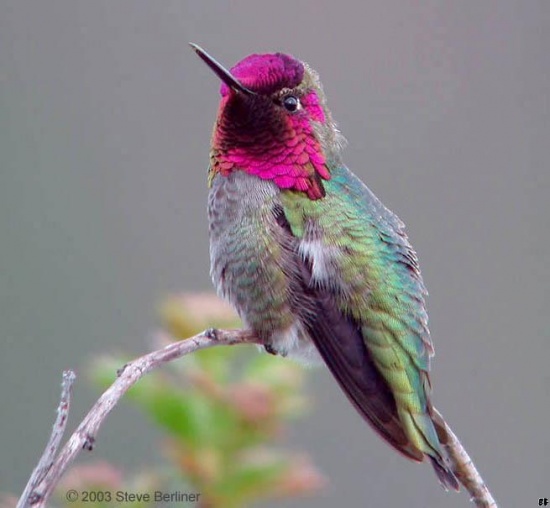(Extra video link. References updated) |
(update link) |
||
| Line 18: | Line 18: | ||
[[North America|North]], [[South America|South]] and [[Central America]]: found in the arid south-west of [[British Columbia]] to north-western [[Baja]]; winters to northern [[Mexico]] | [[North America|North]], [[South America|South]] and [[Central America]]: found in the arid south-west of [[British Columbia]] to north-western [[Baja]]; winters to northern [[Mexico]] | ||
==Taxonomy== | ==Taxonomy== | ||
| − | This is a [[Dictionary_M- | + | This is a [[Dictionary_M-O#M|monotypic]] species<sup>[[#References|[1]]]</sup>. |
| + | |||
==Habitat== | ==Habitat== | ||
Open wooded or shrubby areas and mountain meadows. | Open wooded or shrubby areas and mountain meadows. | ||
Revision as of 01:32, 25 June 2014

Photo by Forcreeks
- Calypte anna
Identification
10cm
- Glossy green back
- Grey below
- Green flanks
- Long, straight and slender bill
Male:
- Glossy red crown and throat
- Dark tail
Female and juvenile:
- Green crown
- Grey throat with some red marking
- Dark tail with white tips.
Distribution
North, South and Central America: found in the arid south-west of British Columbia to north-western Baja; winters to northern Mexico
Taxonomy
This is a monotypic species[1].
Habitat
Open wooded or shrubby areas and mountain meadows.
Behaviour
Breeding
The female builds a large, round, cup nest in a shrub or tree from very small twigs, lichen and other mosses, and often lined with downy feathers or animal hair. It is bound together with spider silk.
Diet
The diet includes nectar and insects.
References
- Clements, JF. 2011. The Clements Checklist of Birds of the World. 6th ed., with updates to August 2011. Ithaca: Cornell Univ. Press. ISBN 978-0801445019. Spreadsheet available at http://www.birds.cornell.edu/clementschecklist/downloadable-clements-checklist
- Avibase
- Wikipedia
External Links





